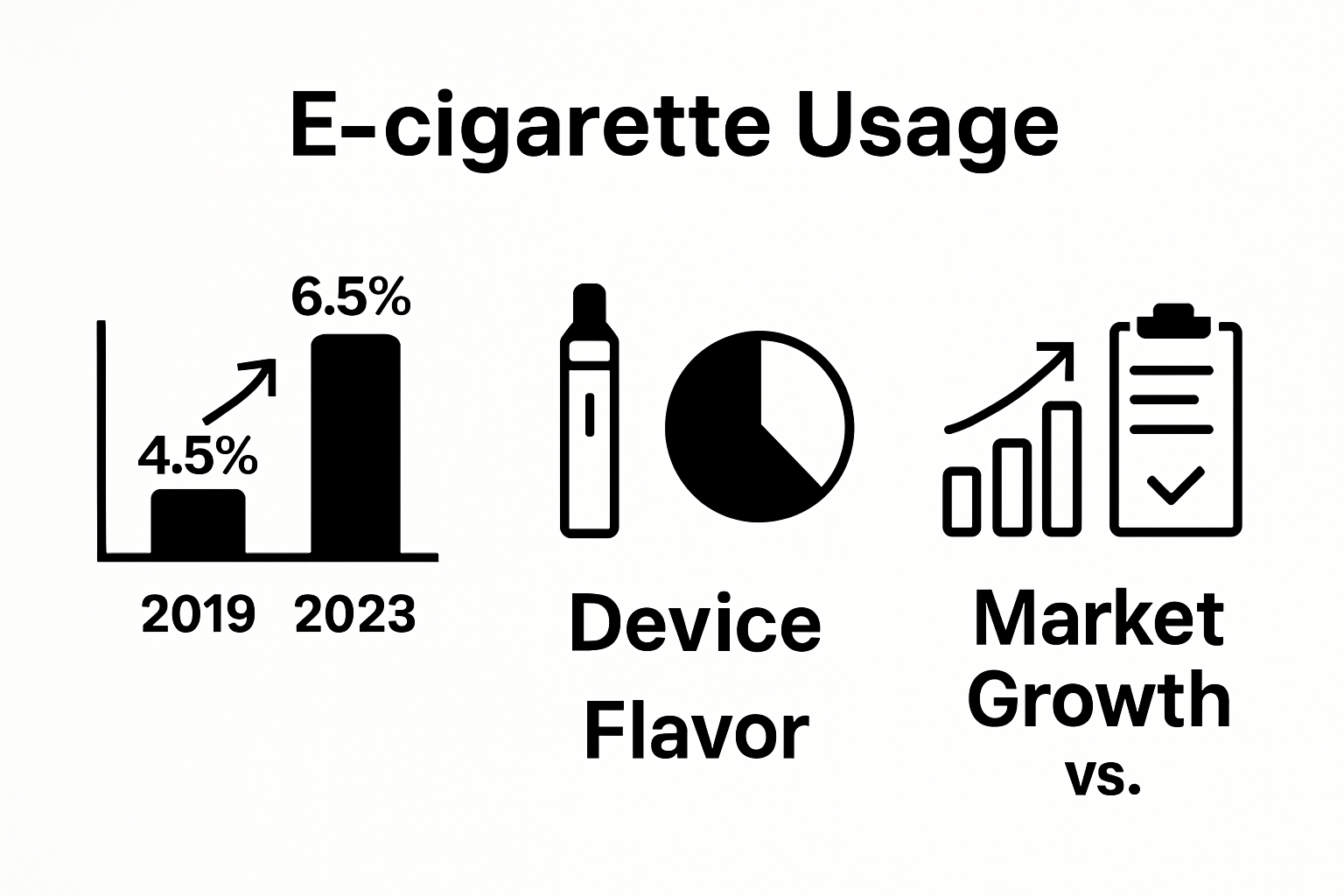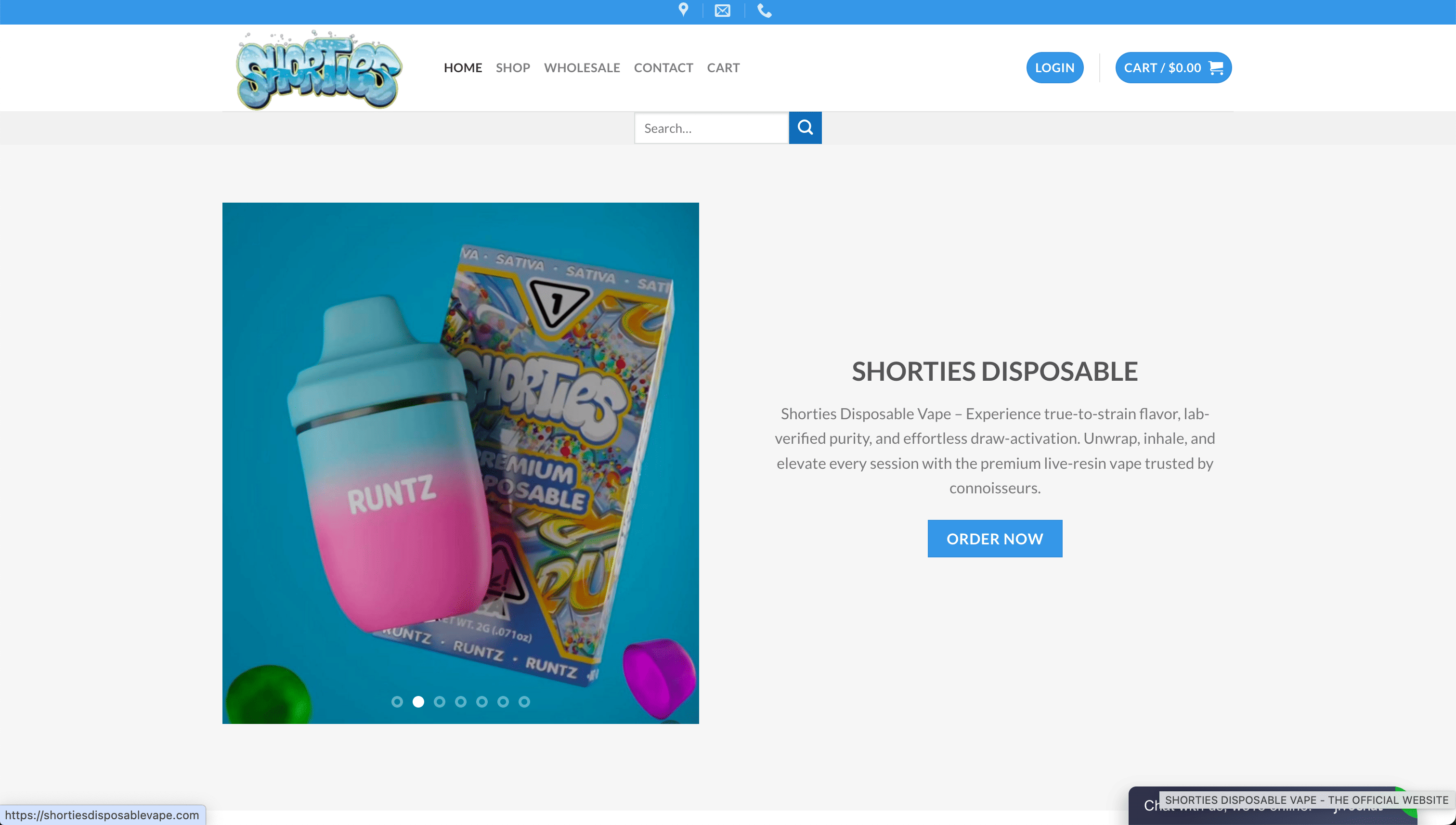Blog
Understanding Vape Usage Trends 2025: Key Insights
Vaping has exploded in popularity and is now embraced by millions worldwide. In fact, adult e-cigarette usage jumped from 4.5 percent in 2019 to 6.5 percent in 2023. Most people think this rise is just a fad or a flashy alternative to smoking. But the real driver is a race in technology that has turned simple vape pens into intelligent, customizable devices with features like Bluetooth connectivity and real-time health tracking.
Table of Contents
- What Is Vaping And How Has It Evolved?
- Why Vape Usage Trends Matter In 2025
- How Market Dynamics Influence Vape Trends
- Emerging Vape Technologies And Their Impact
Quick Summary
| Takeaway | Explanation |
|---|---|
| Vaping technology has advanced significantly. | From basic cig-a-like devices to customizable mods, vaping has evolved to offer better user experiences and health benefits. |
| Vaping trends reflect economic and health shifts. | The growth of vaping markets indicates changing consumer preferences and the need for updated public health policies. |
| Regulatory frameworks are crucial for vaping. | Effective regulations, including age restrictions and product safety, help to balance consumer choice with health risks. |
| Consumer preferences drive product innovation. | The demand for personalization and improved technology shapes the development of new vaping devices and liquids. |
| Sustainability in vaping is becoming a priority. | New technologies focus on environmentally friendly designs, producing devices that are energy efficient and have recyclable components. |
What is Vaping and How Has It Evolved?
Vaping represents a modern technological approach to consuming nicotine and other substances through electronic devices that transform liquid into inhalable vapor. Unlike traditional smoking methods, vaping devices heat a specialized liquid containing nicotine, flavorings, and other chemical compounds to create an aerosol users inhale.
The Technological Genesis of Vaping
The evolution of vaping traces back to the early 2000s when Chinese pharmacist Hon Lik developed the first commercially successful electronic cigarette. Motivated by his father’s death from lung cancer caused by smoking, Lik engineered a device that could deliver nicotine without the harmful combustion byproducts associated with traditional cigarettes.
According to research published in the International Journal of Environmental Research and Public Health, vaping technology has dramatically transformed since its initial introduction. The progression includes:
Below is a comparison table summarizing the evolution of vaping devices, showcasing key characteristics of each generation for easy reference.
| Generation | Key Features | User Experience |
|---|---|---|
| First-generation (Cig-a-like) | Mimics traditional cigarettes in appearance | Basic, easy to use |
| Second-generation (Pod systems) | Refined nicotine delivery, compact design | Improved satisfaction |
| Third-generation (Mod devices) | Customizable, precise control over settings | Advanced, personalized |
| Modern Smart Devices | Bluetooth, health tracking, app integration | Highly personalized |
- First generation “cig-a-like” devices mimicking traditional cigarette appearances
- Advanced pod systems with refined nicotine delivery mechanisms
- Customizable mod devices allowing users precise control over vapor production
Understanding Modern Vaping Mechanics
Modern vaping devices operate through a sophisticated process of electrical heating and liquid transformation. A typical device contains several core components:
- Battery: Provides electrical power to heat the coil
- Atomizer: Transforms liquid into vapor through controlled heating
- E-liquid Chamber: Stores specialized nicotine or cannabinoid-infused liquids
These devices offer users a technologically advanced alternative to traditional smoking, with the ability to control nicotine concentration, flavor profiles, and vapor production. Learn more about our innovative vaping solutions.
The rapid technological evolution of vaping continues to reshape how consumers approach nicotine consumption, emphasizing personalization, reduced health risks, and enhanced user experience.
Why Vape usage Trends Matter in 2025
Vape usage trends represent far more than mere consumer preferences. They are critical indicators of broader societal shifts in health behaviors, technological innovation, regulatory landscapes, and consumer expectations. Understanding these trends provides profound insights into public health, technological advancement, and market dynamics.
Economic and Market Transformation
The vaping industry is experiencing unprecedented growth and transformation. Market research suggests the global vaping market will reach substantial valuation by 2025, driven by technological improvements, changing consumer attitudes, and increased recognition of potential harm reduction strategies compared to traditional smoking.
Key economic implications include:
- Significant job creation in manufacturing and technological sectors
- Substantial tax revenue generation for local and national governments
- Emergence of new business models and entrepreneurial opportunities
Public Health and Regulatory Considerations
Research from the Centers for Disease Control highlights the complex relationship between vaping trends and public health policy. Understanding usage patterns helps policymakers develop nuanced, evidence-based regulations that balance consumer choice with potential health risks.
Important regulatory considerations encompass:
This table organizes the core regulatory considerations that impact vaping, clarifying their focus and significance in the context of public health and safety.
| Regulatory Consideration | Focus Area | Importance |
|---|---|---|
| Age restriction enforcement | Consumer protection | Prevents youth access and underage usage |
| Product safety standards | Device/liquid safety | Ensures reliable, safe products on the market |
| Nicotine concentration limits | Health regulation | Reduces risks associated with high nicotine |
| Marketing regulation | Advertising practices | Restricts youth targeting and misleading claims |
- Age restriction enforcement
- Product safety standards
- Nicotine concentration limits
- Marketing regulation
Explore our comprehensive guide to single-use vape trends to gain deeper insights into these emerging market dynamics.
Technological Innovation and Consumer Preferences
Vape usage trends serve as a critical barometer for technological innovation. Consumer preferences drive rapid advancements in device design, battery technology, liquid formulations, and user experience. By 2025, we anticipate seeing more personalized, safer, and more efficient vaping technologies that cater to increasingly sophisticated user demands.
The intersection of consumer trends, technological capabilities, and regulatory frameworks will continue to reshape the vaping landscape, making ongoing analysis and understanding crucial for businesses, consumers, and policymakers alike.
How Market Dynamics Influence Vape Trends
Market dynamics represent a complex interplay of consumer behaviors, technological innovations, regulatory frameworks, and economic factors that collectively shape the trajectory of vaping industries worldwide. Understanding these intricate relationships provides critical insights into how vaping markets transform and adapt.
Consumer Preferences and Product Evolution
Consumer demands fundamentally drive market transformations in the vaping landscape. Modern users seek products that offer personalization, convenience, and enhanced user experiences. According to research from the Centers for Disease Control, adult e-cigarette usage increased from 4.5% in 2019 to 6.5% in 2023, demonstrating significant market growth.
Key consumer preference drivers include:

- Compact and portable device designs
- Diverse flavor profiles
- Advanced technological features
- Customizable nicotine concentrations
Economic and Regulatory Influences
Economic factors and regulatory environments play pivotal roles in shaping vaping market dynamics. Governments worldwide are implementing nuanced policies that balance consumer choice with public health considerations. Explore our comprehensive guide on vape product trends to understand these complex interactions.
Significant market influencers encompass:
- Taxation policies
- Age restriction regulations
- Product safety standards
- Marketing limitation guidelines
Technological Innovation and Market Adaptation
Technological advancements serve as critical catalysts for market transformation. Manufacturers continuously develop more sophisticated devices that address user preferences while meeting increasingly rigorous safety and performance standards. By 2025, we anticipate seeing vaping technologies that offer greater personalization, enhanced battery efficiency, and more precise nicotine delivery mechanisms.
The ongoing interaction between consumer expectations, technological capabilities, and regulatory frameworks will continue to reshape vaping markets, creating dynamic and responsive ecosystems that prioritize user experience and safety.

Emerging Vape Technologies and Their Impact
The vaping landscape is undergoing rapid technological transformation, with innovations that promise enhanced user experiences, improved safety features, and more sophisticated consumption methods. These emerging technologies are reshaping how consumers interact with vaping devices, pushing boundaries of performance, personalization, and precision.
Smart Device Integration and Connectivity
Research published in the International Journal of Environmental Research and Public Health highlights the growing trend of technologically advanced vaping devices. Modern vape technologies are integrating smart features that extend far beyond traditional nicotine delivery, transforming these devices into intelligent, connected platforms.
Key technological advancements include:
- Bluetooth-enabled devices for usage tracking
- Mobile app integration for personalized settings
- Temperature and voltage control mechanisms
- Real-time health monitoring capabilities
Advanced Liquid Formulation Technologies
Liquid formulation represents another frontier of vaping innovation. Manufacturers are developing more sophisticated e-liquid compositions that offer improved flavor profiles, more precise nicotine delivery, and enhanced safety standards. Explore our comprehensive guide to flavor innovations to understand these groundbreaking developments.
Critical advancements in liquid technology encompass:
- Pharmaceutical-grade nicotine extraction
- Customizable concentration levels
- Enhanced flavor stability
- Reduced chemical complexity
Sustainability and Environmental Consciousness
Emerging vape technologies are increasingly focusing on sustainability and environmental impact. Manufacturers are developing devices with longer lifespans, recyclable components, and more energy-efficient designs. By 2025, we anticipate seeing vaping technologies that not only deliver superior user experiences but also minimize environmental footprints.
The convergence of technological innovation, user-centric design, and environmental consciousness is driving a new generation of vaping devices that offer unprecedented levels of performance, personalization, and responsible consumption.
Take Charge of Vape Trends with Trusted Solutions
As vape markets rapidly evolve in 2025, you may notice how trends like advanced technology, flavor innovation, and heightened safety expectations can make it tough to find a vape you actually trust. The article has highlighted key issues such as the demand for lab-tested products, authenticity verification, and the need for eco-friendly vaping. We understand that as a consumer, you want to keep up with the latest while feeling confident about quality and transparency.

Experience the difference with Shorties Disposable, where every device is crafted to meet the highest standards. With transparent lab results, clear information on specifications, and a dedicated recycling program, you can shop for premium live-resin cannabis vapes and know exactly what you are inhaling. Ready for clarity, safety, and premium features in your vape experience? Shop Shorties now and lead the trend toward smarter, safer vaping.
Frequently Asked Questions
What are the key trends in vape usage for 2025?
The key trends in vape usage for 2025 include an increase in consumer preferences for personalized devices, diverse flavor profiles, and advanced technological features. The market is also seeing significant growth driven by health-conscious consumers seeking alternatives to traditional smoking.
How do consumer preferences influence vape device design?
Consumer preferences greatly influence vape device design. Users are looking for compact, portable devices with customizable options for flavor and nicotine concentration, as well as advanced technological features that enhance user experience and personalization.
What is the impact of regulatory policies on vape usage trends?
Regulatory policies can significantly impact vape usage trends by enforcing age restrictions, setting safety standards, and guidelines for marketing. These regulations aim to balance consumer choice with public health considerations, influencing how products are marketed and consumed.
What advancements can we expect in vape technology by 2025?
By 2025, we can expect significant advancements in vape technology, including smart device integrations for personalized settings, improvements in liquid formulation for better flavor and safety, and a focus on sustainability with eco-friendly device designs.
Recommended
- Understanding Why Single Use Vapes Are Popular Today
- Understanding the Role of Flavor Profiles in Vapes
- 7 Examples of Vape Flavor Profiles to Try Now
- Warranty in Disposable Vapes Explained

